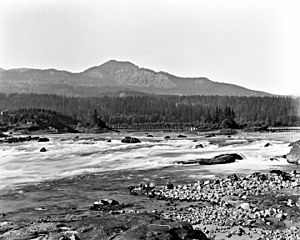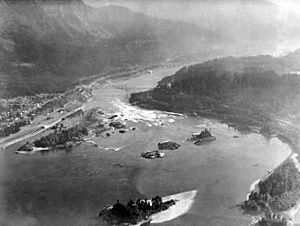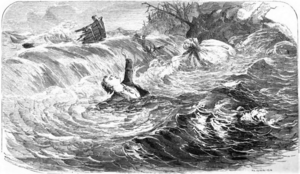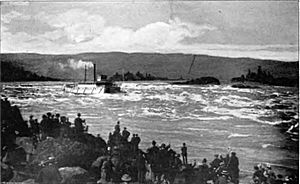Cascades Rapids facts for kids
The Cascades Rapids were a powerful and fast-moving section of the Columbia River in North America. They were located between the U.S. states of Washington and Oregon. The river dropped about 40 feet (12 meters) over 2 miles (3.2 kilometers) in this area.
These rapids, and others in the Columbia River Gorge, gave the nearby mountains their name: the Cascade Range.
In 1896, the Cascade Locks and Canal were built to help boats get around the rapids. Later, in the 1930s, the Bonneville Dam was constructed. This dam caused the river to rise, covering the rapids and most of the old locks.
Contents
An Important Fishing Spot
The Cascades Rapids were a very important place for Native Americans. They would come here to catch salmon. Salmon swim upstream to lay their eggs, and the rapids made it easier to catch them.
A Challenge for Pioneers
The rapids were a big problem for pioneers traveling on the Oregon Trail. Early travelers would stop at The Dalles. From there, they hoped to find small boats to take them to the Willamette Valley.
In 1845, a pioneer named Sam Barlow built a road. This road went around the south side of Mount Hood. It allowed travelers to avoid the difficult rapids on the last part of their journey.
Traveling through the rapids was very hard and dangerous. People had to move their boats and supplies by hand. Sometimes, boats were damaged by hitting rocks. Native Americans lived in this area and often helped or interacted with the travelers.
Moving Boats and Supplies
Boat travelers had to either carry their boats and supplies around the rapids (called a portage) or pull their boats upriver with ropes.
Disagreements Over Passage
For a long time, there were disagreements between the Chinookan Native Americans and European and American traders. The Native Americans believed they controlled passage through the area. However, many newcomers did not respect this.
By the early 1800s, some fur traders used force against the Native Americans. Later, more peaceful ways were found. In the 1830s, a serious illness greatly reduced the number of Native Americans in the area. This meant they were no longer as powerful along the river.
To protect the portage road, three forts were built between 1855 and 1856. These were Fort Cascades, Fort Raines, and Fort Lugenbeel. Native Americans burned Fort Cascades in 1856, but it was rebuilt. This attack led to the building of Fort Lugenbeel.
Steamboats on the River
The Cascades were a major barrier for steamboats. Steamboats could not travel upstream through the fast water. Going downstream was very risky, but skilled captains sometimes managed it.
In 1896, a special canal and lock system was finished. This allowed boats to bypass the rapids. This area is now called Cascade Locks, Oregon.
By 1938, the rapids were gone. They were covered by the Bonneville Reservoir, which formed behind the Bonneville Dam. The Bonneville Lock at the dam, finished in 1937, replaced the older Cascade Locks.





